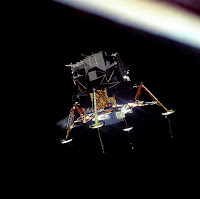A transit of Venus across the Sun takes place when the planet Venus passes directly between the Sun and Earth, obscuring a small portion of the solar disk. During a transit, Venus can be seen from Earth as a small black disk moving across the face of the Sun. The duration of such transits is usually measured in hours (the transit of 2004 lasted six hours). A transit is similar to a solar eclipse by the Moon. While the diameter of Venus is almost 4 times that of the Moon, Venus appears smaller, and travels more slowly across the face of the Sun, because it is much farther away from Earth. Observations of transits of Venus helped scientists use the principle of parallax to calculate the distance between the Sun and the Earth.
Transits of Venus are among the rarest of predictable astronomical phenomena. They occur in a pattern that repeats every 243 years.The first of a pair of transits of Venus in the beginning of the 21st century took place on 8 June 2004 and the next will be on 6 June 2012. After 2012, subsequent transits of Venus will be in December 2117 and December 2125.
Aside from its rarity, the original scientific interest in observing a transit of Venus was that it could be used to determine the size of the solar system by employing the parallax method.
The technique involved making precise observations of the slight difference in the time of either the start or the end of the transit from widely separated points on the Earth's surface. The distance between the points on the Earth was then used as a baseline to calculate the distance to Venus and the Sun via triangulation.
The transit pair of 1761 and 1769 were used to try to determine the precise value of the distance from the Earth to the Sun (astronomical unit (AU)) using parallax. In 1716 Halley suggested a high-precision measurement of the distance between the Earth and the Sun by timing the transit of Venus. Halley gained agreement for the project to go ahead, but died more than 25 years before the measurement took place. Numerous expeditions were made to various parts of the world in order to observe these transits; an early example of international scientific collaboration. In an attempt to observe the first transit of the pair, scientists and explorers from Britain, Austria and France travelled to destinations around the world, including Siberia, Norway, Newfoundland and Madagascar.[18] Most managed to observe at least part of the transit, but excellent readings were made in particular by Jeremiah Dixon and Charles Mason at the Cape of Good Hope.
 For the 1769 transit, scientists traveled to Hudson Bay, Baja California (then under Spanish control), and Norway. Observations were also made from Tahiti on the first voyage of Captain Cook, at a location still known as "Point Venus".
For the 1769 transit, scientists traveled to Hudson Bay, Baja California (then under Spanish control), and Norway. Observations were also made from Tahiti on the first voyage of Captain Cook, at a location still known as "Point Venus".In 1771, using the combined 1761 and 1769 transit data, the French astronomer Jérôme Lalande calculated the astronomical unit to have a value of 153 million kilometers (±1 million km). The precision was less than hoped-for because of the black drop effect.















